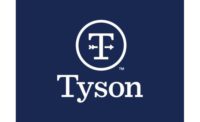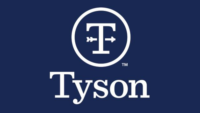Tyson Foods reports second quarter 2023 results
Results show strong branded food performance and continued focus on growth strategy.

Credit: Tyson Foods Inc.
Tyson Foods Inc., one of the world’s largest food companies with protein brands including Tyson, Jimmy Dean, Hillshire Farm, Ball Park, Wright, Aidells, ibp and State Fair, is reporting the following results:
(in millions, except per share data) |
Second quarter |
|
Six months ended |
|||||||||
|
|
2023 |
|
|
|
2022 |
|
|
2023 |
|
|
2022 |
Sales |
$ |
13,133 |
|
|
$ |
13,117 |
|
$ |
26,393 |
|
$ |
26,050 |
|
|
|
|
|
|
|
|
|||||
Operating income (loss) |
$ |
(49 |
) |
|
$ |
1,156 |
|
$ |
418 |
|
$ |
2,611 |
Adjusted operating income (non-GAAP) |
$ |
65 |
|
|
$ |
1,161 |
|
$ |
518 |
|
$ |
2,593 |
|
|
|
|
|
|
|
|
|||||
Net income (loss) per share attributable to Tyson |
$ |
(0.28 |
) |
|
$ |
2.28 |
|
$ |
0.61 |
|
$ |
5.35 |
Adjusted net income (loss) per share attributable to Tyson (non-GAAP) |
$ |
(0.04 |
) |
|
$ |
2.29 |
|
$ |
0.82 |
|
$ |
5.16 |
The company reports its financial results in accordance with U.S. generally accepted accounting principles (GAAP). As used in this table and throughout this earnings release, adjusted operating income (loss) and adjusted net income (loss) per share attributable to Tyson (adjusted EPS) are non-GAAP financial measures.
First six months highlights include:
- Sales of $26,393 million, up 1.3% from prior year
- GAAP operating income of $418 million, down 84% from prior year. Adjusted operating income of $518 million, down 80% from prior year.
- GAAP EPS of $0.61, down 89% from prior year. Adjusted EPS of $0.82, down 84% from prior year
- Total company GAAP operating margin of 1.6%. Adjusted operating margin (non-GAAP) of 2.0%.
- Repurchased 5.1 million shares for $332 million
Second quarter highlights include:
- Sales of $13,133 million flat from prior year
- GAAP operating loss of $49 million, down 104% from prior year. Adjusted operating income of $65 million, down 94% from prior year.
- GAAP EPS of $0.28, down 112% from prior year. Adjusted EPS of $0.04, down 102% from prior year.
- Total company GAAP operating margin of 0.4%. Adjusted operating margin (non-GAAP) of 0.5%.
- Liquidity of $2.2 billion at April 1, 2023. On May 3, 2023, entered into $1.75 billion of new term loan facilities.
"While the current protein market is challenging, we have a strong growth strategy in place and are bullish on our long-term outlook,” said Donnie King, president and CEO of Tyson Foods. “We saw strong performance in our branded foods business and continue to be laser-focused on meeting customer needs and planning the future with them.”
“Through our growth strategy, focus on margin improvement, and proven leadership team, I am confident in our ability to capture the opportunities in front of us and create long-term value for customers, team members, and shareholders,” he said
Segment results (in millions)
Sales | ||||||||||||||||||||
(for the second quarter and six months ended April 1, 2023, and April 2, 2022) | ||||||||||||||||||||
|
Second quarter |
Six months ended |
||||||||||||||||||
|
|
|
Volume |
Avg. price |
|
|
Volume |
Avg. price |
||||||||||||
|
|
2023 |
|
|
2022 |
|
Change |
Change |
|
2023 |
|
|
2022 |
|
Change |
Change |
||||
Beef |
$ |
4,617 |
|
$ |
5,034 |
|
(2.9)% |
(5.4)% |
$ |
9,340 |
|
$ |
10,036 |
|
— |
% |
(6.9)% |
|||
Pork |
|
1,421 |
|
|
1,565 |
|
1.1 |
% |
(10.3)% |
|
2,950 |
|
|
3,191 |
|
(3.2)% |
(4.4)% |
|||
Chicken |
|
4,430 |
|
|
4,086 |
|
6.4 |
% |
2.0 |
% |
|
8,693 |
|
|
7,976 |
|
4.5 |
% |
4.5 |
% |
Prepared Foods |
|
2,422 |
|
|
2,393 |
|
(0.4)% |
1.6 |
% |
|
4,960 |
|
|
4,726 |
|
0.4 |
% |
4.6 |
% |
|
International/Other |
|
634 |
|
|
565 |
|
8.0 |
% |
4.2 |
% |
|
1,246 |
|
|
1,115 |
|
7.2 |
% |
4.5 |
% |
Intersegment Sales |
|
(391 |
) |
|
(526 |
) |
n/a |
n/a |
|
(796 |
) |
|
(994 |
) |
n/a |
n/a |
||||
Total |
$ |
13,133 |
|
$ |
13,117 |
|
3.3 |
% |
(3.2)% |
$ |
26,393 |
|
$ |
26,050 |
|
2.1 |
% |
(0.8)% |
||
Operating income (loss) | |||||||||||||||||||
(for the second quarter and six months ended April 1, 2023, and April 2, 2022) | |||||||||||||||||||
|
Second quarter |
Six months ended |
|||||||||||||||||
|
|
|
Operating margin |
|
|
Operating margin |
|||||||||||||
|
|
2023 |
|
|
2022 |
|
2023 |
|
2022 |
|
|
2023 |
|
|
2022 |
2023 |
|
2022 |
|
Beef |
$ |
— |
|
$ |
638 |
|
— |
% |
12.7 |
% |
$ |
166 |
|
$ |
1,594 |
1.8 |
% |
15.9 |
% |
Pork |
|
(33 |
) |
|
59 |
|
(2.3)% |
3.8 |
% |
|
(54 |
) |
|
223 |
(1.8)% |
7.0 |
% |
||
Chicken |
|
(258 |
) |
|
198 |
|
(5.8)% |
4.8 |
% |
|
(189 |
) |
|
338 |
(2.2)% |
4.2 |
% |
||
Prepared Foods |
|
241 |
|
|
263 |
|
10.0 |
% |
11.0 |
% |
|
499 |
|
|
449 |
10.1 |
% |
9.5 |
% |
International/Other |
|
1 |
|
|
(2 |
) |
n/a |
n/a |
|
(4 |
) |
|
7 |
n/a |
n/a |
||||
Total |
$ |
(49 |
) |
$ |
1,156 |
|
(0.4)% |
8.8 |
% |
$ |
418 |
|
$ |
2,611 |
1.6 |
% |
10.0 |
% |
|
Adjusted segment results (in millions)
Adjusted operating income (loss) (non-GAAP) | |||||||||||||||||||
(for the second quarter and six months ended April 1, 2023, and April 2, 2022) | |||||||||||||||||||
|
Second quarter |
Six months ended |
|||||||||||||||||
|
|
|
Adjusted operating margin (non-GAAP) |
|
|
Adjusted operating margin (non-GAAP) |
|||||||||||||
|
|
2023 |
|
|
2022 |
|
2023 |
|
2022 |
|
|
2023 |
|
|
2022 |
2023 |
|
2022 |
|
Beef |
$ |
8 |
|
$ |
638 |
|
0.2 |
% |
12.7 |
% |
$ |
137 |
|
$ |
1,594 |
1.5 |
% |
15.9 |
% |
Pork |
|
(31 |
) |
|
59 |
|
(2.2)% |
3.8 |
% |
|
(50 |
) |
|
223 |
(1.7)% |
7.0 |
% |
||
Chicken |
|
(166 |
) |
|
203 |
|
(3.7)% |
5.0 |
% |
|
(89 |
) |
|
320 |
(1.0)% |
4.0 |
% |
||
Prepared Foods |
|
252 |
|
|
263 |
|
10.4 |
% |
11.0 |
% |
|
518 |
|
|
449 |
10.4 |
% |
9.5 |
% |
International/Other |
|
2 |
|
|
(2 |
) |
n/a |
n/a |
|
2 |
|
|
7 |
n/a |
n/a |
||||
Total |
$ |
65 |
|
$ |
1,161 |
|
0.5 |
% |
8.9 |
% |
$ |
518 |
|
$ |
2,593 |
2.0 |
% |
10.0 |
% |
Outlook
For fiscal 2023, the United States Department of Agriculture (USDA) indicates domestic protein production (beef, pork, chicken and turkey) should increase slightly compared to fiscal 2022 levels. The following is a summary of the updated outlook for each of Tyson's segments, as well as an outlook for revenues, capital expenditures, net interest expense, liquidity and tax rate for fiscal 2023. Certain of the outlook numbers include adjusted operating margin (a non-GAAP metric) for each segment. The company is not able to reconcile its full-year fiscal 2023 projected adjusted results to its fiscal 2023 projected GAAP results because certain information necessary to calculate such measures on a GAAP basis is unavailable or dependent on the timing of future events outside of the company's control. Therefore, because of the uncertainty and variability of the nature of and the amount of any potential applicable future adjustments, which could be significant, the company is unable to provide a reconciliation for these forward-looking non-GAAP measures without unreasonable effort. Adjusted operating margin should not be considered a substitute for operating margin or any other measures of financial performance reported in accordance with GAAP. Investors should rely primarily on the company’s GAAP results and use non-GAAP financial measures only supplementally in making investment decisions.
Beginning in fiscal 2022, Tyson launched a new productivity program, which is designed to drive a better, faster and more agile organization that is supported by a culture of continuous improvement and faster decision making. They targeted an aggregate $1 billion in productivity savings by the end of fiscal 2024, relative to a fiscal 2021 cost baseline. They realized more than $700 million of productivity savings in fiscal 2022, which partially offset the impacts of inflationary market conditions, and they have surpassed their aggregate $1 billion target as of the end of the second quarter of fiscal 2023 — more than a year ahead of their plan.
- Beef: USDA projects domestic production will decrease approximately 4% in fiscal 2023 as compared to fiscal 2022. Tyson anticipates an adjusted operating margin of (1)% to 1% in fiscal 2023 as margins are expected to decrease.
- Pork: USDA projects domestic production will be relatively flat in fiscal 2023 as compared to fiscal 2022. Tyson anticipates adjusted operating margin of (2)% to 0% in fiscal 2023.
- Chicken: USDA projects chicken production will increase approximately 3% in fiscal 2023 as compared to fiscal 2022. Tyson anticipates an adjusted operating margin of (1)% to 1% for fiscal 2023.
- Prepared Foods: Tyson anticipates an adjusted operating margin of 8% to 10% in fiscal 2023, driven by volume growth, productivity and disciplined revenue management.
- International/Other: Tyson anticipates improved results from their foreign operations in fiscal 2023.
- Revenue: Tyson expects sales to be $53 billion to $54 billion in fiscal 2023.
- Capital expenditures: Tyson expects capital expenditures of approximately $2.3 billion for fiscal 2023. Capital expenditures include spending for capacity expansion and utilization, automation to alleviate labor challenges and brand and product innovation.
- Net interest expense: Tyson expects net interest expense to approximate $340 million for fiscal 2023.
- Liquidity: Tyson expects total liquidity, which was approximately $2.2 billion at April 1, 2023, to remain above their minimum liquidity target of $1.0 billion. On May 3, 2023, they entered into $1.75 billion of new term loan facilities.
- Tax rate: Tyson currently expects their adjusted effective tax rate to be around 22% for fiscal 2023.
Source: Tyson Foods Inc.
Looking for a reprint of this article?
From high-res PDFs to custom plaques, order your copy today!






